Why we do NOT need to enshrine abortion rights into law: Position Paper # 66
by Joyce Arthur, ARCC, www.arcc-cdac.ca
Lire en français: https://www.arcc-cdac.ca/media/position-papers/fr/66-pas-besoin-inscrire-droit-avortement-loi.pdf
Why we do NOT need to enshrine abortion rights into law
Do we need a federal law that guarantees the right to abortion and access to the service? Some pro-choice commentators and academics think so. However, the Abortion Rights Coalition of Canada (ARCC)’s position is that we should not enshrine abortion rights into law. We believe this could politicize the issue even more and subject the right to interference and attacks in the future.
First, it’s not clear that the federal government even has jurisdiction over this issue, since healthcare is a provincial matter. We certainly do not want a federal criminal law.
If the current Liberal government were to pass a civil law guaranteeing abortion rights, a real risk is that they might end up compromising on some kind of “middle ground” after the various consultations, debates, and committee deliberations. The Conservative opposition would also no doubt try to amend the law during its passage. These scenarios could result in restrictions added to the law, such as gestational limits, waiting periods, mandatory counselling, or other criteria.
Even if we ended up with a great law that fully guaranteed reproductive rights and access, it would open the door to legal challenges by anti-choice groups, as well as ongoing attempts to place limits, such as bans on certain reasons for abortion (such as sex selection or disability) or the “right” of healthcare workers to refuse to assist in any way with abortion care, without penalty. A future Conservative government could even repeal the law or make it far more restrictive. In other words, the very existence of a law guaranteeing abortion rights poses a threat to its promise.
Moreover, would this law really help protect abortion rights and improve access, or would it just be window dressing? How much political enthusiasm would we see when it comes to implementing the law? We should also remember that laws and the justice system tend to be used not to help marginalized groups but to control them, including people of colour, Indigenous peoples, 2S/LGBTQI+ people, sex workers, and of course ciswomen. A well-intentioned law could potentially do more harm than good, or not much good at all.
Some assert that the lack of a law, in itself, means that abortion rights cannot be fully realized, or makes our rights vulnerable to attack and subject to the vagaries of politics. But there is no evidence for that. ARCC has always said that a new abortion law could in fact give the anti-choice movement a useful platform from which to launch attacks. It seems to be the lack of a law in Canada that has made it difficult for anti-choice activists to make headway. Since 1988, they have never passed a private member bill or won a court case against abortion rights. While they’ve certainly tried and will continue, we believe the absence of an existing law has enfeebled their attempts in large part because they have no framework to modify or dismantle.
Further, ARCC has always upheld Canada’s lack of a law as a model for the rest of the world. Activists in other countries have been inspired by our example in their own attempts to liberalize or repeal abortion laws. (These include most Australian states, Ireland, the UK, New Zealand, South Korea, and others.)
No need to amend the Charter – abortion rights are already protected
What about adding abortion to the Charter as a protected constitutional right? First, amending the Charter is a difficult process and it’s rarely been done except for a few unremarkable provincial things, so it would likely be impossible for a national issue as contentious as abortion. Most Charter amendments can be passed only if identical resolutions are adopted by the House of Commons, the Senate and two-thirds or more of the provincial legislative assemblies representing at least 50 per cent of the national population. The two most comprehensive attempts to revise the Charter were both defeated. There have been 13 amendments since 1982, but most have been limited in scope, dealing only with matters affecting specific provinces.
Even if such an amendment was passed, conservative provinces could invoke the Notwithstanding clause (section 33), which authorizes governments to override many fundamental rights and freedoms.
Amending the Charter is also unnecessary because abortion can already be considered a Charter right. A broad and completely unrestricted right to abortion exists now in Canada due to court precedents and Charter rights. Some have incorrectly said that abortion is not truly a legal right in Canada because abortion is neither legal nor illegal, or we’re in a legal vacuum that needs filling, or our rights rest on a shaky foundation.
But court precedent is law – it’s called common law. Abortion is explicitly legal in Canada because of the 1988 Morgentaler decision, which struck down the old abortion law because it violated the right to bodily security (and the rights to life, liberty, conscience, and privacy according to Justice Bertha Wilson).
Further court precedents have solidified this right, and legal experts such as Daphne Gilbert at the University of Ottawa consider it unlikely that a new law regulating abortion could withstand Charter scrutiny under Section 7, which guarantees the right to life, liberty and security of the person. “I think that Section 7 has evolved now to a point where if it was presented to the court, they would say, yes, there’s a constitutional right to have an abortion,” Gilbert said in May 2022.
ARCC has explained why abortion is a Charter right, pointing out that gender equality rights under Section 15 of the Charter should protect abortion rights in today’s courts. New Brunswick is currently being sued over its abortion payment regulation, on grounds that it is unconstitutional and violates the Canada Health Act. (https://ccla.org/major-cases-reports/nb-abortion-rights/ccla-wins-first-round-of-abortion-challenge-in-new-brunswick/)
The 2016 medical assistance in dying law was challenged as too restrictive. The government lost, but its 2020 amendments represent a “failure to go further and address the expectations of Canadians… It represents a cowardice unbecoming of caring government.” (https://navltd.com/insights/what-the-liberals-got-right-and-wrong-in-long-overdue-reforms-to-assisted-dying/) When the Supreme Court decided the 1988 Morgentaler case, the Section 15 anti-discrimination clause (including on the basis of sex) was not cited as it was only added in 1985 and still quite new. The first Supreme Court case to rely on Section 15 was in 1990. (https://www.justice.gc.ca/eng/csj-sjc/rfc-dlc/ccrf-ccdl/check/art15.html)
Since restrictions on abortion target only people who can get pregnant, they would automatically violate gender equality rights – not just under the Charter, but also provincial human rights codes. Further, international human rights agreements and jurisprudence protect the right of reproductive self-determination and the right to safe abortion. Canada must comply with the international instruments it has ratified, such as the Convention on the Elimination of All Forms of Discrimination against Women.
Legislators do not belong in doctor’s offices
No healthcare procedure should have its own law. After all, we don’t have laws regulating heart surgery or appendectomy. Unfortunately, Canada has two exceptions – a regulation in New Brunswick that restricts funded abortions to hospitals, and a federal criminal law that allows medical assistance in dying but with limits. Both laws have harmed people and restricted their rights, thereby serving as examples of the danger of laws intruding into medical affairs.
New Brunswick is currently being sued over its abortion payment regulation, on grounds that it is unconstitutional and violates the Canada Health Act. (https://ccla.org/major-cases-reports/nb-abortion-rights/ccla-wins-first-round-of-abortion-challenge-in-new-brunswick/)
The 2016 medical assistance in dying law was challenged as too restrictive. The government lost, but its 2020 amendments represent a “failure to go further and address the expectations of Canadians… It represents a cowardice unbecoming of caring government.” (https://navltd.com/insights/what-the-liberals-got-right-and-wrong-in-long-overdue-reforms-to-assisted-dying/)
In Canada, we leave medical protocols to the discretion of provincial Colleges of Physicians and Surgeons, and the Canadian Medical Association. This should serve for abortion care as well, which is regulated by various medical policies, codes, and guidelines the same as any other healthcare. However, it must be said that the reality of ongoing abortion stigma requires far more pro-active effort by these quite conservative medical bodies, which fall far short in supporting providers and ensuring accessibility.
This is what we need instead of a law
ARCC believes the access barriers we still experience in Canada are not due to the lack of a law, as some have claimed. Rather, they stem largely from abortion stigma, fear of political controversy or of being harassed, anti-choice sentiment in some provincial governments and medical organizations, and the federal government’s lack of enforcement of the Canada Health Act.
This is what needs to happen instead of a law enshrining abortion rights:
– The federal government must properly enforce the Canada Health Act to equalize and expand abortion access across the country. It’s not enough to withhold a small portion of health transfer payments from provinces that contravene the Act, as this does nothing to alleviate the underlying problem.
– The federal government must increase healthcare funding to the provinces and direct them to expand sexual and reproductive healthcare, including abortion.
– The federal government must publish accurate information on abortion at the Health Canada website including refuting abortion myths. It must also take action against anti-choice groups that spread medical misinformation and undermine abortion rights, by eliminating their government funding and revoking their charitable tax status.
– Provincial governments must ensure access in every region so people don’t have to travel, allow nurse practitioners and midwives to provide abortion care including Mifegymiso prescriptions, and protect patients and medical staff from anti-choice harassment. (These actions can be done via policy or specific legislation, such as a safe access zone law or a regulation requiring certain hospitals to provide abortion.)
– Medical schools must provide comprehensive training and opportunities for future abortion providers, and require all Obstetrics & Gynecology residents to learn surgical abortion techniques, with no opt-out.
– The provincial Colleges of Physicians and Surgeons, and the Canadian Medical Association, must encourage and support abortion providers, and work with the provinces to provide abortion care in every region.
These bodies must also regulate the practice of belief-based care denial, the refusal by healthcare workers to provide care they personally disagree with. International protocols must be followed that mandate limits on such refusals (see the sections on CEDAW, WHO, and FIGO), such as requiring objectors to provide an effective referral (as in Ontario and Nova Scotia), accurate information, and emergency care. Further, ARCC urges that objectors be monitored and disciplined for violating policies, and that care denials based on personal beliefs be recognized as harmful to patients and not a “right”.
– Finally, all of us need to continue exposing the misinformation and harmful propaganda spread by anti-choice groups. Their main objectives are to reinforce abortion stigma, promote traditional gender roles and deny 2SLBGTQI+ rights, undermine the legitimacy of abortion rights, and re-criminalize abortion.
In conclusion, we don’t need a new federal law to accomplish the above objectives – we just need to use the tools we already have. They include not just the Canada Health Act and the Charter, and a commitment to reproductive rights, but most of all, political will and courage.



